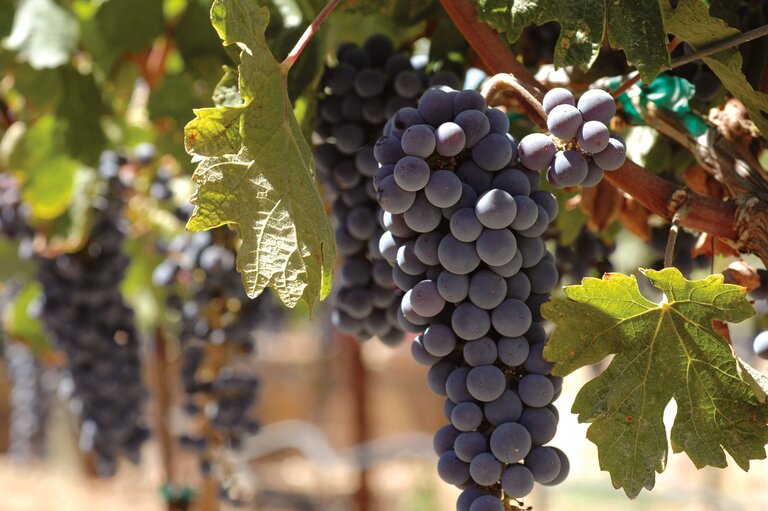Paso Robles vs. Bordeaux - Which Wines Rule? Part 1
In Part 1 of a two-part series, JUSTIN sommelier Jim Gerakaris discusses the differences between growing and making Bordeaux-style wines in the Bordeaux region of France and in Paso Robles, California.
May 30, 2014

There are key differences between growing and making Bordeaux-style wines in the Bordeaux region of France and in Paso Robles, California. Let’s explore how cabernet sauvignon and other affiliated grape varieties of the Bordeaux region – cabernet franc, merlot, petit vedot, and malbec – can be used to craft outstanding, varied wines due to regional differences between Bordeaux and Paso.
BORDEAUX
Cabernet sauvignon is often thought of as the core Bordeaux grape variety, but in reality, it is the star only in one part of the region – referred to as the Left Bank, specifically the Médoc. In fact, cabernet sauvignon is the only one of Bordeaux’s* five main varieties that we know for certain originated in the Médoc.
A crossing (or “child”) of cabernet franc and sauvignon blanc, cabernet sauvignon quite literally has its roots in the Médoc and is perfectly suited to the region’s climate and soils. Let’s take a closer look at why this grape variety shines so brightly there.
With a forest on its western side protecting it from the cold Atlantic winds and the Gironde River to the east, the Médoc sees temperatures that are only a few degrees warmer than the area known as the Right Bank. Cabernet sauvignon is a late-ripening variety that has adapted well to the weather of its home region. But when planted in the marginally cooler Libournais (Right Bank), it doesn’t achieve the same greatness. For that reason, merlot – an earlier-ripening variety – is the dominant grape in Right Bank regions like Saint-Émilion and Pomerol.
SOIL
Of course, no discussion of winegrowing would be complete without talking about soils. The Médoc’s soils are well suited to cabernet sauvignon – but maybe not for the reasons you might think. While the parent material for most of the region’s soils is calcaire (a type of limestone also found in parts of Paso Robles), the real magic comes from the interaction of soil, climate, and geography.
The best vineyards in the Médoc, especially for cabernet sauvignon, are planted on large gravel mounds deposited by the Gironde River over millennia. These raised mounds improve drainage by lowering the water table, which is essential for the sensitive roots of the vines. Like Paso Robles, Bordeaux grapples with water – but in Bordeaux, the problem is too much water. While clay exists beneath many vineyard sites, the difference between a First Growth château and a Cru Bourgeois often lies in the complex interaction of water table depth, topsoil quality, gravel, sand, and underlying clay deposits.
WEATHER
Weather is another major point of difference. Unlike Paso Robles, Bordeaux receives rain throughout the year, with an average of about 24 inches annually – including nearly two inches during the summer growing season (June through August) and about three inches in September alone. That means a wet harvest is a common risk.
Historically, Bordeaux was considered a marginal climate for late-ripening grapes, with just one or two “great vintages” per decade. Climate change has altered this landscape, with the last 20 years being only slightly cooler than Napa Valley.
In Bordeaux’s cooler years, wines were often hit-or-miss – great vintages were truly great, while others were well… sub-par. Young wines could be hard, with harsh tannins and green, herbaceous notes. Today, Bordeaux is producing more ripe, early developing wines (though still requiring 5 to 10 years to soften), thanks both to warmer conditions and to critical acclaim favoring more fruit-forward, approachable styles.
In summary, Bordeaux’s reputation as a benchmark for cabernet sauvignon is rooted in its unique combination of climate, soil, and tradition. The Médoc’s gravelly terrain, moderated weather, and long history of blending have shaped some of the world’s most age-worthy wines. As we turn our focus to Paso Robles in Part 2, we’ll explore how a newer winegrowing region with dramatically different conditions produces wines that stand confidently on their own – distinct in style, but no less compelling.
*The five main Bordeaux varieties are cabernet sauvignon, merlot, cabernet franc, petit verdot, and malbec.